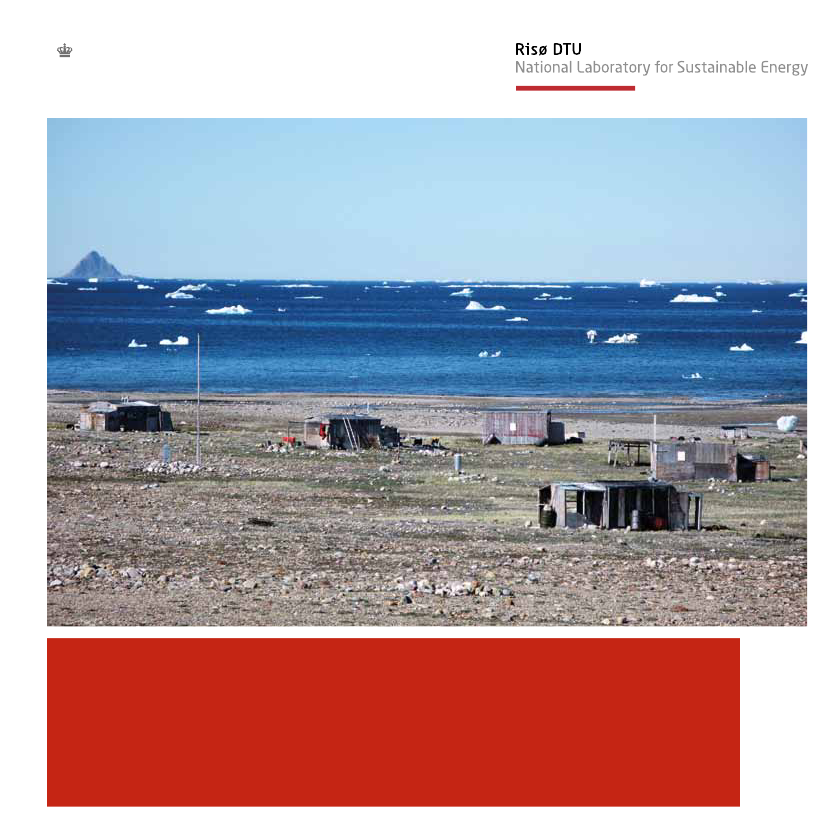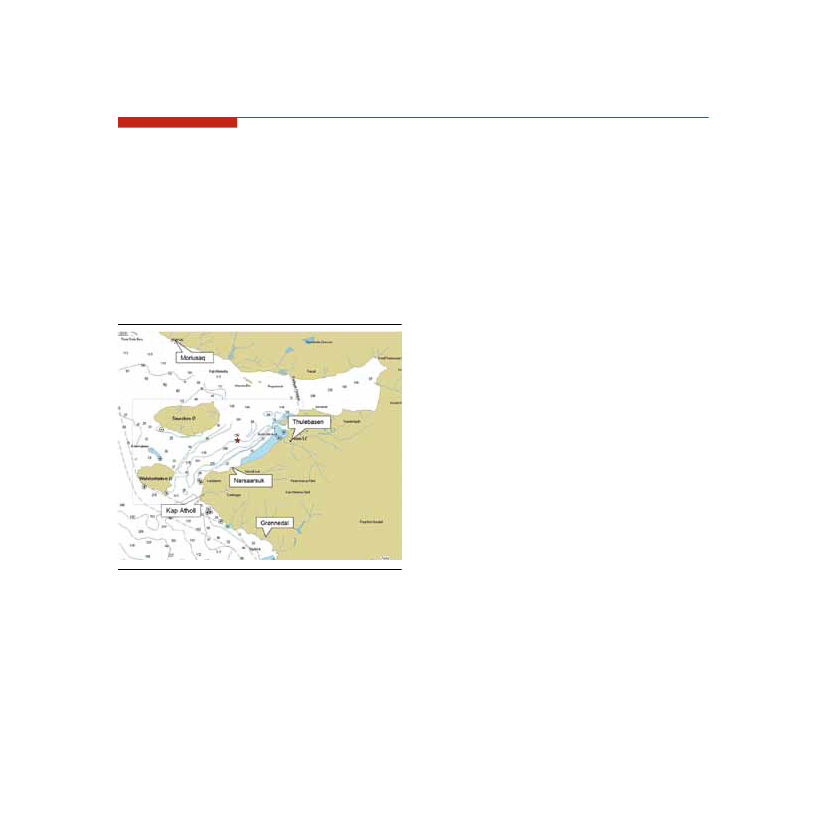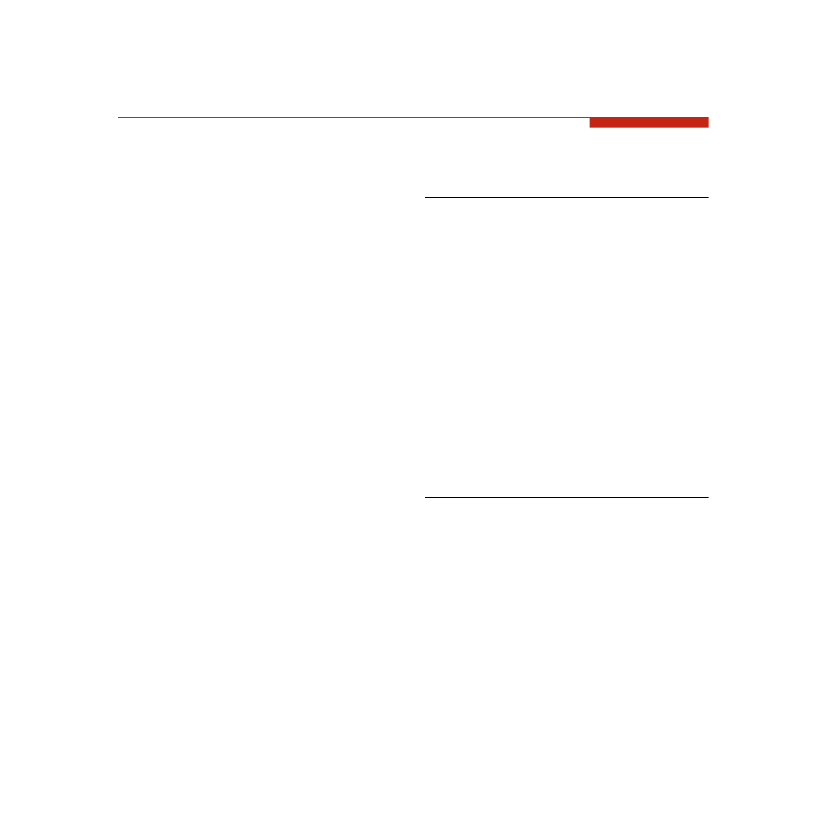Grønlandsudvalget 2011-12, Forsvarsudvalget 2011-12
GRU Alm.del Bilag 23, FOU Alm.del Bilag 171
Offentligt
SundhedsstyrelsenStatens Institut for Strålebeskyttelse
InvestIgatIon Into terrestrIalradIoactIve contamInatIon at thuleand assessment of radIatIon doses
2011
Investigation into Terrestrial Radioactive Contamination at Thule andAssessment of Radiation Doses� Sundhedsstyrelsen, 2011National Board of HealthIslands Brygge 672300 Copenhagen SDenmarkwww.sst.dkKeywords: Greenland, Thule, plutonium, accident, contamination, radiation doses, risk assessmentCategory: Professional AdviceLanguage: EnglishVersion: 1.0Version Date: 21 November 2011Format: pdfTransalation: Dansk Engelsk Oversættelse- og SprogserviceCover Photo: Svend K. OlsenPrinting and Layout: Rosendahl-Schultz Grafisk A/S, Herstedvang 10-12, 2620 Albertslund, DenmarkPublished by National Board of Health and Risø DTU, December 2011.
Investigation into terrestrial radioactivecontamination at thule and assessment ofradiation dosesBackgroundIn January 1968, an American B-52 bombercrashed into the sea ice in the vicinity of ThuleAir Base in Greenland. As a result of the acci-dent, radioactive material from the damagednuclear weapons was dispersed in smoke fromthe burning engine fuel. The majority of theradioactive material landed on the ice surround-ing the crash site and was subsequently cleanedup by the USA. Smaller amounts of the radio-active material were carried by the wind south-ward over the land. In the years following theaccident, Risø DTU has undertaken multiplestudies of the marine environment and hasrecorded significant contamination on the sea-floor beneath the crash site, with low levels oftransfer to animals and marine plants.In 2003, terrestrial contamination was recordedat the Narsaarsuk hunting station, which islocated on the coast, 8 km south of the crashsite. It was decided to undertake studies of ter-restrial contamination in order to assess the riskfor any humans who might be present in thestudied areas and who might inhale radioactiveparticles, which can be stirred up out of the soilby wind and by dust-producing activities.The results of the studies are assembled in areport by the Radiation Research Division atRisø DTU, and associated assessments of radia-tion doses are provided in a report by theNational Institute of Radiation Protection with-in the National Board of Health. A combinedsummary of the two reports is offered below,accompanied by conclusions and recommenda-tions.
studiesThe studies involved sampling of soil and mak-ing measurements in the Thule area in the sum-mers of 2007 and 2008. Besides Narsaarsuk, thestudies covered Thule Air Base, Saunders Island,
Investigation into terrestrial radioactive contamination at thule and assessment of radiation doses
3
Wolstenholme Island, Kap Atholl (on the coast,15 km south of Narsaarsuk, occasionally usedfor recreational activities), Grønnedal (coastalhunting area 20 km south of Narsaarsuk), andMoriusaq (40 km northwest of Thule Air Base).Overview map of the Thule area
vehicles as means of transport from Thule AirBase to the study sites, for instance to transportequipment to Narsaarsuk. While at the sites,research was done primarily on foot.A large number of soil samples as well as sam-ples of air, rain, and airborne and soil particleswere taken near Narsaarsuk, where contamina-tion had previously been recorded. Collectionof air, rain, and particle samples took placeover periods of two to eight weeks in 2007and 2008. Portable equipment was used tomake supplemental measurements of soil con-tamination in places with raised contamina-tion levels.The collected samples were transported to RisøDTU and analysed in the laboratory in order todetermine the presence of radioactive material.The analyses included plutonium isotopes aswell as americium. Americium occurs as animpurity in plutonium.
Overview map of the Thule area, showing the crash site (star) andthe hunting area around Kap Atholl, Grønnedal, Narsaarsuk,Saunders Island, Wolstenholme Island, the Thule Air Base, andthe Moriusaq settlement.
results from the radioactivitymeasurementsAnalyses of soil samples show great variation inradioactive contamination near Narsaarsuk. Theresults vary from the background level for pluto-
The Thule area is characterised by uneven ter-rain and changeable weather conditions. Projectparticipants utilised motorboats and all-terrain
4
Investigation into terrestrial radioactive contamination at thule and assessment of radiation doses
nium at 20–40 Bq m-2to more than 1 MBq m-2.Raised contamination levels occur sporadicallyin places that face north and are damp in thesummer, presumably due to the deposition andsubsequent melting of snow that was contami-nated following the accident. Contaminationoccurs primarily in the uppermost soil layer, at0–2 cm.The total amount of plutonium in the soil nearNarsaarsuk is estimated to be 0.1 kg, comparedwith the estimated 1 kg on the seabed. This isin relation to the total 7–8 kg of plutoniumthat the B-52 plane is estimated to have carried.The area around the Narsaarsuk hunting stationwas systematically surveyed for radioactive con-tamination, but it was not possible to undertakea systematic search for raised radiation levelsthroughout the region as a whole. It is thusimpossible to rule out the existence of othersites, besides those that have already been iden-tified, with raised contamination levels.Analyses of soil samples from Kap Atholl andGrønnedal show contamination levels that arelower than near Narsaarsuk but still significantlyabove the background level. Analyses of soilsamples from Thule Air Base, Moriusaq,
Saunders Island, and Wolstenholme Island showradioactive contents at the background level: Inother words, there are no signs of contamina-tion from the 1968 plane crash.Near Narsaarsuk, extremely small quantities ofplutonium were found in airborne particulatescollected with air filters and sticky foils. Bothtest types resulted in air concentrations at thesame low levels as are found in Europe. Rainsamples collected near Narsaarsuk also containedsmall quantities of plutonium, also amountingto very low airborne concentrations. No samplesof air or rain from Narsaarsuk showed signs ofparticles with raised plutonium content.Reports on Terrestrial Contamination in Thulethule-2007 – Investigation of radioactive pollutionon land, risø dtu 2011, risø-r-1781(en), http://www.risoedtu.dk/Knowledge_base/publications/reports/ris-r-1781.aspxthe thule accident: assesement of radiation dosesfrom terrestrial radioactive contamination, nationalInstitute of radiation Protection 2011, www.sst.dk/publ2011/sIs/thule/sIs_thule_rapport_2011_en.pdf
Investigation into terrestrial radioactive contamination at thule and assessment of radiation doses
5
assessment of radiation dosesThe potential risk for humans present in thestudied areas has been assessed in such a way asto consider all of the ways in which peoplecould be exposed to radiation from the radioac-tive material that was dispersed following theThule accident. For every exposure pathway,radiation doses have been calculated on thebasis of the measured contamination levels aswell as a number of variables concerning timespent in the area,etc.The contaminating radioactive material atThule does not emit significant amounts ofpenetrating radiation. Stays in the area thus donot result in external irradiation, for instance ofthe sort resulting from an x-ray examination.Irradiation can therefore only occur if the radio-active material enters a person’s body so thatradiation exposure occurs internally. This canhappen if the radioactive material occurs in aform in which it may enter a person’s bodythrough inhalation, the consumption of con-taminated foodstuffs, or through wounds andcuts in the skin.Based on international recommendations a radi-ation dose of 1 mSv/year has been selected as a
reference for comparison against the calcula-tions. This Thule reference level forms the basisfor assessing whether special control or protec-tion measures are necessary as a result of terres-trial contamination in the Thule area. As acomparison with the Thule reference level, wecan note that Greenlanders and Danes receiveapproximately 1 mSv/year as a result of natural-ly occurring radiation sources such as cosmicrays from space and naturally occurring radioac-tive materials in soil, construction material, andfoodstuffs (natural background radiation).Furthermore, the Danish dose limit for mem-bers of the public as a result of planned expo-sure from all sources of radiation is also 1mSv/year. A dose of 1 mSv/year has no signifi-cance to health.Radiation Dose from InhalationThe dose from inhalation of radioactive materi-al due to stays in the area is calculated on thebasis of the measured concentrations of plutoni-um in the air for one person, who is assumed tospend 14 days/year in the area. The result is andose of 0.000,000,1 mSv/year. This is anextremely small dose.
6
Investigation into terrestrial radioactive contamination at thule and assessment of radiation doses
Radiation Dose from Ingesting Musk OxMeatMeat from musk oxen is the most significantsource of terrestrial mammal meat from theThule area in the diets of the local population.No measurements of plutonium and americiumin musk ox meat have been undertaken in theThule area or elsewhere in Greenland. Generallyspeaking, however, plutonium is transferredvery poorly by the digestive systems of bothhumans and animals, including ruminants suchas musk oxen. The possibility of contaminationof musk ox meat is therefore assessed on thebasis of general considerations and knowledgeof meat contamination from other ruminantspresent in areas contaminated by plutoniumelsewhere in the world, though grazing condi-tions may have differed elsewhere. If such a pro-visional assessment is based on cattle in theUSA and sheep in the United Kingdom, and ifit is assumed that an individual consumes 15 kgof musk ox meat/year, the resultant dose frommeat ingestion is 0.000,1 mSv annually.Although this dose is greater than the inhalationdose, it must still be regarded as being extremelysmall.
GlossaryPlutonium and Americium:the radioactive materials plutonium-239 andamericium-241.Bq (becquerel):unit of activity, i.e. the quantity of a given radioac-tive material.1 mBq (megabecquerel) = 1,000,000 Bq.Bq m-2(becquerel per square meter).mSv (millisievert):unit of radiation dose.Order of Magnitude Estimate:radiation doses are given in factors of 10, forinstance 1, – 0.1, – 0.01, and – 0.001.
Investigation into terrestrial radioactive contamination at thule and assessment of radiation doses
7
A superior assessment of dose from meat inges-tion could be obtained by collecting and meas-uring samples of musk ox meat taken in theThule area. The National Institute of RadiationProtection does not anticipate that such meas-urements would show plutonium concentra-tions in the meat that deviate significantly (forinstance, by a factor of 100-1000) from theplutonium content in the meat estimated forthe provisional dose calculation. The doseassessment for meat ingestion can therefore beregarded as broadly robust when considered inlight of the reference level of 1 mSv/year.Radiation Dose from WoundContaminationWounds and cuts on individuals present in con-taminated areas can be contaminated by dust,soil, or particles. Soil and other foreign materi-als will normally be thoroughly washed andcleaned from wounds and cuts. If soil or parti-cles remain in the skin after cleaning, these canbe absorbed by the body. If the soil or a particleis contaminated by radioactive material, thiscould result in internal irradiation of the body.The probability of a wound contaminant con-taining radioactive material from the Thuleaccident is very small, and the probability of aperson being exposed to such wound contami-
nation more than once in his or her life is there-fore exceptionally small.If a wound should, however improbably, never-theless be contaminated by radioactive material,a dose is calculated on the basis of the measuredplutonium concentrations in the soil and parti-cles. The calculation assumes that 0.1 g of soilor a particle of the most-radiating size enters awound. The result in this case is a dose of 0.001mSv/year for soil in the wound or 0.1 mSv/yearfor a particle in the wound. These doses are verysmall.Total DoseThe calculations and dose assessments havebeen undertaken on the basis of very conserva-tive assumptions, which likely overestimateactual doses. Calculations and assessments are,however, subject to uncertainty and qualifica-tions. By the same token, the results are pre-sented as order of magnitude estimates of dose,and the results are valid for all individuals (from“tourists” to Greenlandic trappers) and for allages (from children to adults) who might stay inthe studied areas.If the results of the three means of radiationexposure (ingestion, inhalation, and wound
8
Investigation into terrestrial radioactive contamination at thule and assessment of radiation doses
contamination) are combined, it is assessed that,even under extreme conditions and assump-tions, the total dose for individuals in the Thulearea resulting from the 1968 Thule accident issmaller than the applied reference level of 1mSv/year and therefore has no significance tohealth.
and deposited in the sediments nearNarsaarsuk, where the stream runs out intothe sea. These sediments should be analysedfor potential radioactive contents as a resultof the accident. Information on radioactivitylevels in the sediments is relevant for esti-mating the total inventory of plutoniumthat was dispersed by the 1968 accident.�
recommendationsOn the basis of the research conducted, RisøDTU can, from a radioecological perspective,make the following recommendations concern-ing further planning and measurements:�
A number of small areas were found nearNarsaarsuk with raised plutonium levels onthe ground surface. It is necessary to ascer-tain whether there are other sites in theregion featuring significantly raised levels ofradioactivity as a result of the accident.The occurrence of multiple sites nearNarsaarsuk with raised radioactivity levelssuggests that significant contaminant disper-sal from the 1968 accident has taken place.It is likely that radioactive particles were car-ried by meltwater and precipitation to thelocal stream, by which they were transported
Wild animals in the area may be contami-nated by radioactivity, especially at sites nearNarsaarsuk with raised levels. A screeningprogram should be carried out, testing forthe presence of radioactive material in gameanimals from the area. Relevant game mayinclude musk oxen, arctic hare, and birds.
�
On the basis of Risø DTU’s research as well asthe calculations and dose assessments undertak-en, the National Institute of RadiationProtection can, from the perspective of radia-tion protection and public health, make the fol-lowing recommendations regarding the need forfollow up on the measurements and assess-ments, including assessments on the need forfuture measurements:�
From a radiation protection assessment per-spective, based on the current use of the
Investigation into terrestrial radioactive contamination at thule and assessment of radiation doses
9
contaminated area in Thule, there is no needfor restrictions to stays, etc. or for decon-tamination measures in the area.�
the assumptions for this assessment remainvalid, a small, tailored survey should be car-ried out every 5 to 10 years.�
As noted in the assessment of the radiationdose resulting from ingestion of foodstuffs,no direct measurements of plutonium inmusk oxen from the Thule area or otherparts of Greenland are currently available. Asa result, the assessment has relied on modelsbased on experiences from contaminatedlocations elsewhere in the world, which dif-fer from the conditions in the Thule area interms of climate,etc.The dose calculationsfrom meat ingestion could thus be betterqualified via a small survey program thatsamples musk oxen and other terrestrialmammals from the Thule area. The collectedsamples should then also be measured forthe presence of the naturally occurring radi-oactive material polonium-210, which isestimated to cause significantly higher dosesthan the plutonium contamination does.The assessment of radiation doses resultingfrom plutonium contamination for peoplein the Thule area is based on Risø DTU'sresearch up to and including 2008, appliedto the current use of the area. To ensure that
The assessed radiation doses for people inthe Thule area are significantly lower thanthe recommended Thule reference level.There is thus no need, from a dose monitor-ing perspective, to analyse for the presenceof plutonium in individuals living in thearea in survey programs such as the searchfor plutonium in the urine of previousNarsaarsuk residents carried out in 1989.If plans arise for changed use of the area, forinstance involving the construction of build-ings or other installations, including long-term stays or residence in the area, the needfor restrictions concerning stays,etc.in thearea or for decontamination measures shouldbe reconsidered in detail prior to the plan’scommencement.Protection measures such as signposting orfencing off selected areas for reasons notrelated to radiation protection would notinfluence the National Institute of RadiationProtection’s assessment of the total radiationdose for people in the Thule area, including
�
��
10
Investigation into terrestrial radioactive contamination at thule and assessment of radiation doses
radiation dose assessments for people taskedwith placing or maintaining signs or fencing.�
Decontamination measures could cause thedisturbance and stirring up of plutoniumduring decontamination, potentially raisingthe radiation exposure of not only the peo-ple undertaking the operations but also ofthe local population. Decontamination oper-ations should thus not be decided upon orcommenced prior to the completion of acomprehensive radiation protection safetyassessment for such a project.
Investigation into terrestrial radioactive contamination at thule and assessment of radiation doses
11
www.sst.dkNational Board of HealthNational Institute of Radiation Protection[email protected]
















